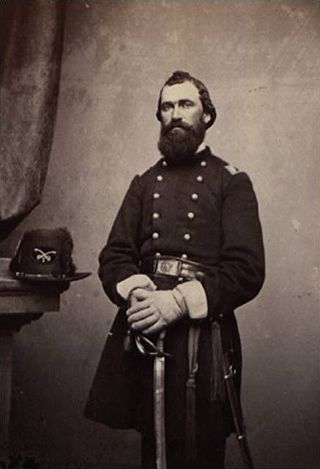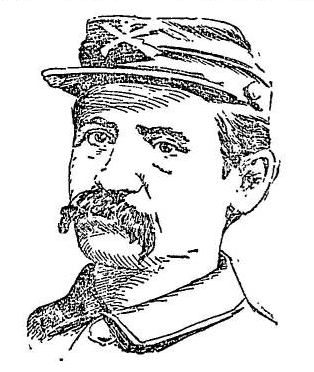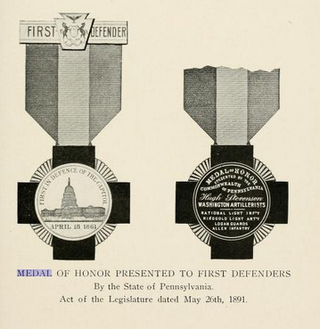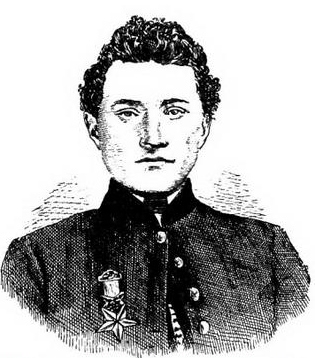History
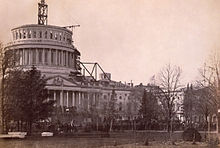
In anticipation of the call by President Abraham Lincoln for volunteer troops to assist in the defense of the nation's capital following the firing on Fort Sumter by Confederate States forces on April 12, 1861, 476 officers and enlisted men from the communities of Allentown, Lewistown, Pottsville, and Reading, Pennsylvania, who were already active with existing militia units in those communities (the Allen Rifles of Allentown, Logan Guard of Lewiston, National Light Infantry and Washington Infantry of Pottsville, and Ringgold Light Artillery of Reading), began equipping themselves on April 13, and assembled in Harrisburg on April 17, two days after Lincoln issued his proclamation requesting the response of 75,000 volunteers. Administered the oath of service on April 18, 1861 at the railroad station in Harrisburg, they departed aboard Northern Central Railroad boxcars, and arrived at noon at the Bolton Station in Baltimore, Maryland, where they disembarked. After marching two miles to the Camden Station, they boarded a new train and headed for Washington, D.C., where they arrived at 6:00 p.m. Later given the honorific of "First Defenders" in recognition of their prompt action, they were initially stationed in various rooms of the United States House of Representatives and Senate before moving to the U.S. Capitol Building where, at 9:00 p.m. that same evening, they were issued new Springfield rifles and ammunition as Lincoln and key members of his cabinet looked on. Afterward, Lincoln shook the hand of each volunteer. [3] [4]
These "First Defenders" were assigned to the regiment's various units as follows: [5] [6]
- Company A: Ringgold Light Artillery (Reading)
- Company D: Logan Guard (Lewiston)
- Company E: Washington Artillery (Pottsville)
- Company G: National Light Infantry (Pottsville)
- Company H: Allen Rifles (Allentown).
On the same day that these First Defenders were arriving in Washington, the remainder of the regiment, which would ultimately be designated as the 25th Pennsylvania Volunteer Infantry, was being organized in Harrisburg, Pennsylvania by Colonel Henry L. Cake, Lieutenant Colonel John B. Selheimer and Major James H. Campbell. They were then also transported via train to Washington, D.C. by way of Baltimore. Initially assigned to the Department of Washington, Companies A, G and H of the First Defenders (the Ringgold Light Artillery, Logan Guard, and Allen Rifles) were quartered in the U.S. Capitol Building, and assigned to guard the Washington Arsenal and Washington Navy Yard while Companies D and E (the Logan Guard and Washington Artillery) were stationed at Fort Washington. The remainder of the 25th Pennsylvania Volunteer Infantry were assigned to tents, and were also stationed near the arsenal. [7] On May 27, 1861, Companies A, G, and H were also assigned to Cake's command. [8]

Companies A and E subsequently remained on duty at the arsenal for the remainder of their service tenure while Companies B, E, and H spent the remainder of their service tenure on garrison duty at Fort Washington. Companies D, F, G, I, and K, which had been placed under the command of Lieutenant Colonel Selheimer, were marched to Rockville, Maryland from June 29 to 30, 1861 and, upon their arrival, were attached to the command of Colonel Charles P. Stone. On July 1, they were ordered to Poolesville, from where they moved to Sandy Hook opposite Harper’s Ferry, at which point Colonel Cake resumed command. Still assigned to Stone's command, they marched for Martinsburg, West Virginia from July 6 to 8, and were attached to Stone’s 7th Brigade in the 3rd Division under Major-General Charles W. Sandford, which was part of the Department of Pennsylvania and the U.S. Army of the Shenandoah headed by Robert Patterson. On July 15, they advanced to Bunker Hill. From July 17 to 23, they made camp near Harper's Ferry. [9]
On July 23, all of the companies which made up the 25th Pennsylvania departed from their respective duty stations, and made their way back, by train, to Harrisburg, where they began to be honorably mustered out through August 1. Many of the members of this regiment then reenlisted for additional service terms with the 96th Pennsylvania Infantry. [10] [11]






